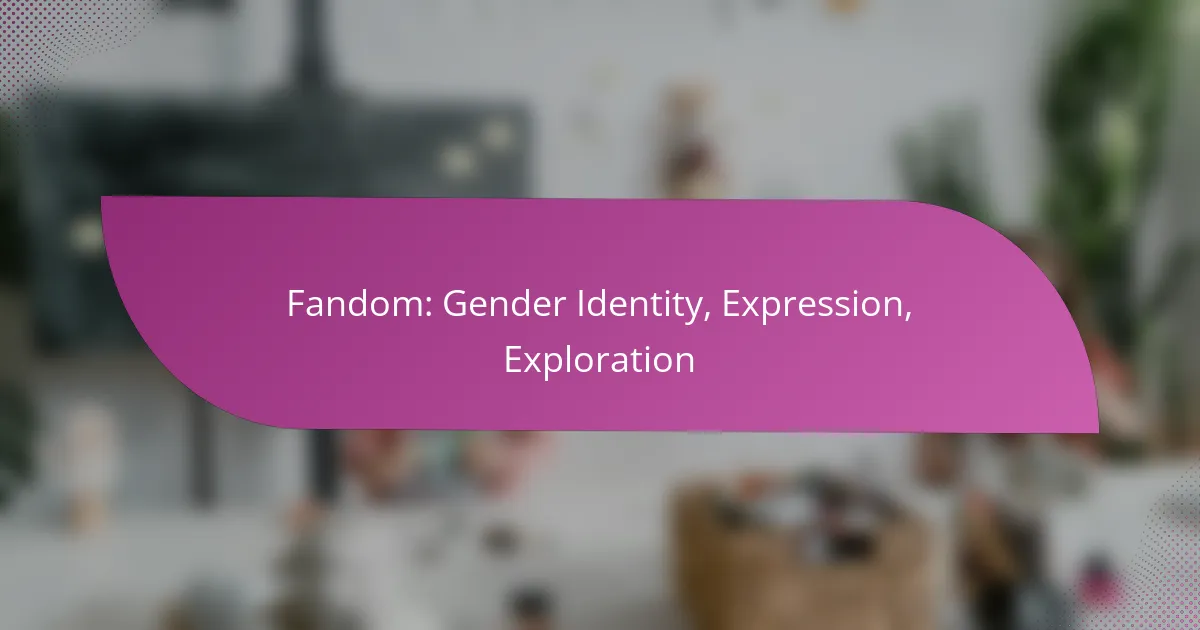Fandom serves as a vital space for individuals to explore and express their gender identity, fostering a sense of community and belonging. Through creative outlets like cosplay and fan art, fans can convey their unique experiences and challenge societal norms, all while connecting with others who share similar journeys. This dynamic environment encourages open discussions and representation, making it a powerful tool for personal exploration and validation.
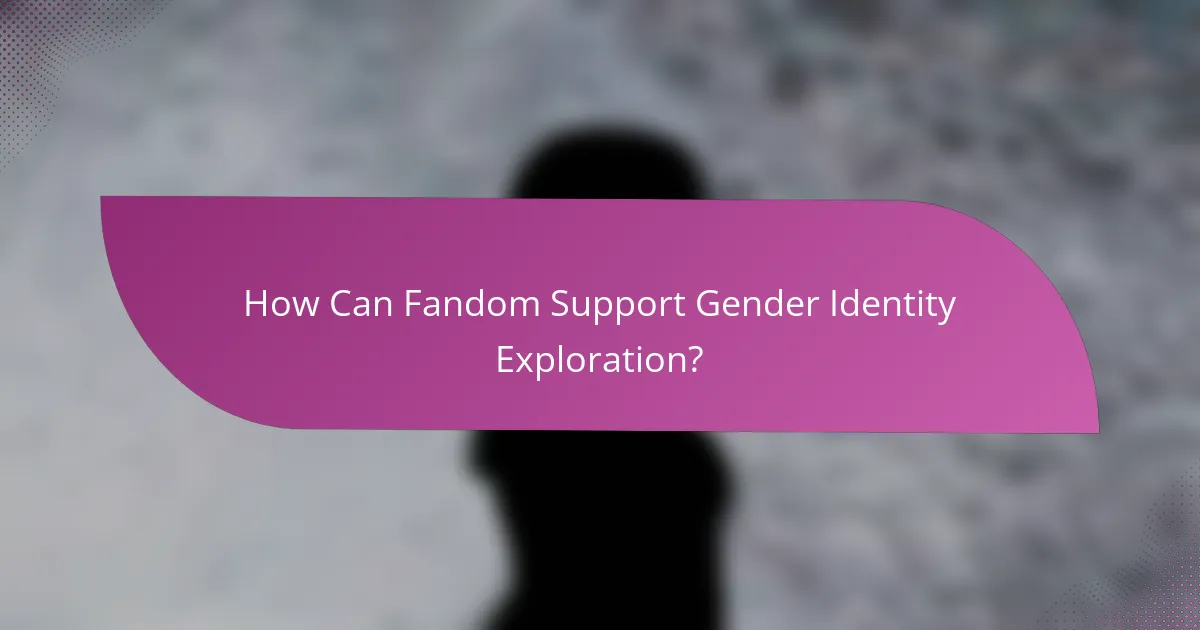
How Can Fandom Support Gender Identity Exploration?
Fandom can significantly aid individuals in exploring their gender identity by providing a welcoming community and resources. Through shared interests, fans can connect, express themselves, and find validation in their experiences.
Community engagement
Engaging with a fandom allows individuals to connect with others who share similar interests and experiences related to gender identity. This engagement fosters a sense of belonging and can lead to meaningful friendships that support personal exploration.
Participating in fan events, online forums, or social media groups can enhance this connection. Look for local meetups or virtual gatherings that focus on inclusive discussions about gender and identity.
Safe spaces for expression
Fandoms often create safe spaces where individuals can express their gender identity without fear of judgment. These environments encourage open dialogue and acceptance, allowing fans to share their thoughts and experiences freely.
To find or establish such spaces, consider joining fan clubs or online communities that prioritize inclusivity. Ensure that these platforms have clear guidelines against harassment and discrimination to maintain a supportive atmosphere.
Representation in media
Media representation within fandoms plays a crucial role in validating diverse gender identities. Characters and narratives that reflect various identities can inspire fans and help them feel seen and understood.
Support shows, books, or games that feature strong, diverse representations of gender. Engage in discussions about these representations to deepen understanding and promote visibility within the community.
Support groups and resources
Many fandoms offer access to support groups and resources that focus on gender identity exploration. These groups can provide guidance, share experiences, and offer practical advice for navigating personal journeys.
Look for local [censured] organizations or online resources that cater to fans. Many communities host workshops, panels, or discussions that can provide valuable insights and support for individuals exploring their gender identity.
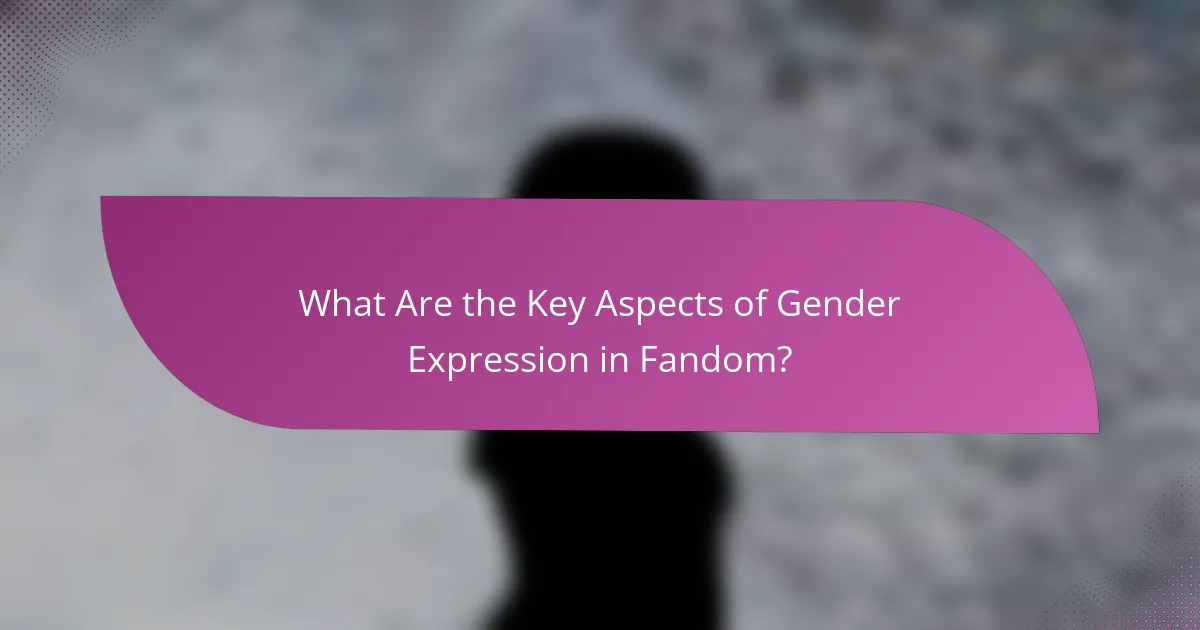
What Are the Key Aspects of Gender Expression in Fandom?
Gender expression in fandom encompasses the ways individuals convey their gender identity through various creative and social outlets. This includes activities like cosplay, fan art, and online discussions that allow fans to explore and express their gender in diverse and meaningful ways.
Cosplay and identity
Cosplay serves as a powerful medium for fans to express their gender identity by embodying characters that resonate with them. Participants often choose characters that reflect their own gender experiences or allow them to explore different aspects of their identity. This can lead to a deeper connection with both the character and the community.
When cosplaying, consider how costume choices, makeup, and performance can enhance your expression. For example, using specific colors or styles may align more closely with your identity or the character’s traits. Engaging with others in the cosplay community can also provide support and validation.
Fan art and representation
Fan art plays a significant role in showcasing diverse gender expressions and identities within fandoms. Artists often create pieces that challenge traditional gender norms, offering representations that resonate with a wide audience. This can include reimagining characters in [censured] or gender-fluid forms, which fosters inclusivity.
To effectively convey gender identity in fan art, focus on elements such as posture, clothing, and facial expressions. These details can communicate a character’s gender identity more clearly. Sharing your art on platforms like DeviantArt or social media can also spark discussions about representation and identity.
Online forums and discussions
Online forums provide a space for fans to discuss gender identity and expression openly. These platforms allow individuals to share their experiences, seek advice, and find community support. Engaging in discussions about gender can help fans articulate their own identities and learn from others’ perspectives.
When participating in these discussions, be respectful and open-minded. Use inclusive language and be aware of varying experiences within the community. Additionally, consider creating or joining groups focused on gender identity to foster deeper connections and understanding among members.
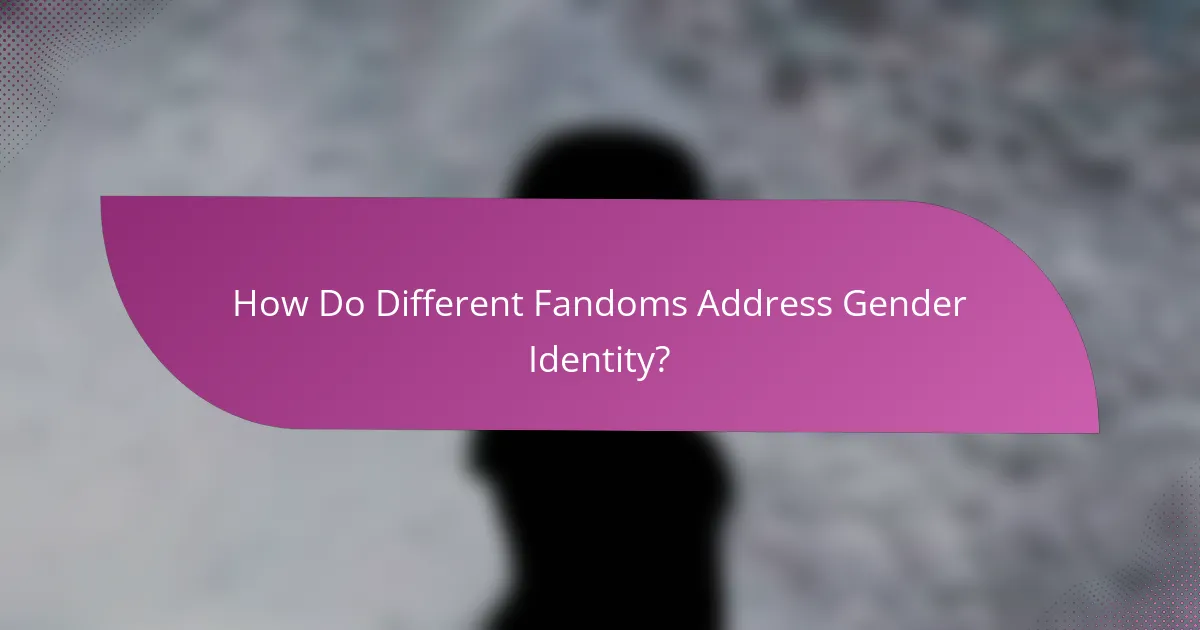
How Do Different Fandoms Address Gender Identity?
Different fandoms approach gender identity through representation, community discussions, and character exploration. These spaces often provide a platform for individuals to express their identities and challenge traditional norms.
Examples from anime fandom
Anime fandom frequently showcases diverse gender identities through characters that defy conventional gender roles. Series like “Ouran High School Host Club” and “Yuri!!! on ICE” feature characters who explore gender fluidity and [censured] identities, encouraging fans to engage with these themes.
Cosplay is another avenue where anime fans express their gender identity. Many cosplayers choose to embody characters that resonate with their personal experiences, often blending gender presentations to reflect their own identities.
Insights from comic book fandom
Comic book fandom has seen significant strides in addressing gender identity, particularly with the introduction of characters like Kate Kane (Batwoman) and Alysia Yeoh, who openly identify as [censured]. These characters not only provide representation but also spark conversations around gender and sexuality within the community.
Comic book conventions often host panels discussing gender identity, allowing fans to share their experiences and perspectives. This fosters a supportive environment where individuals can explore their identities and connect with others who share similar journeys.
Trends in gaming communities
Gaming communities are increasingly recognizing the importance of gender identity in character creation and player representation. Games like “The Last of Us Part II” and “Life is Strange” feature protagonists with diverse gender identities, prompting discussions around inclusivity in gaming.
Online platforms and forums related to gaming often serve as safe spaces for players to discuss their gender identities. However, it’s crucial for these communities to actively combat toxic behavior and promote respectful dialogue to ensure a welcoming environment for all players.
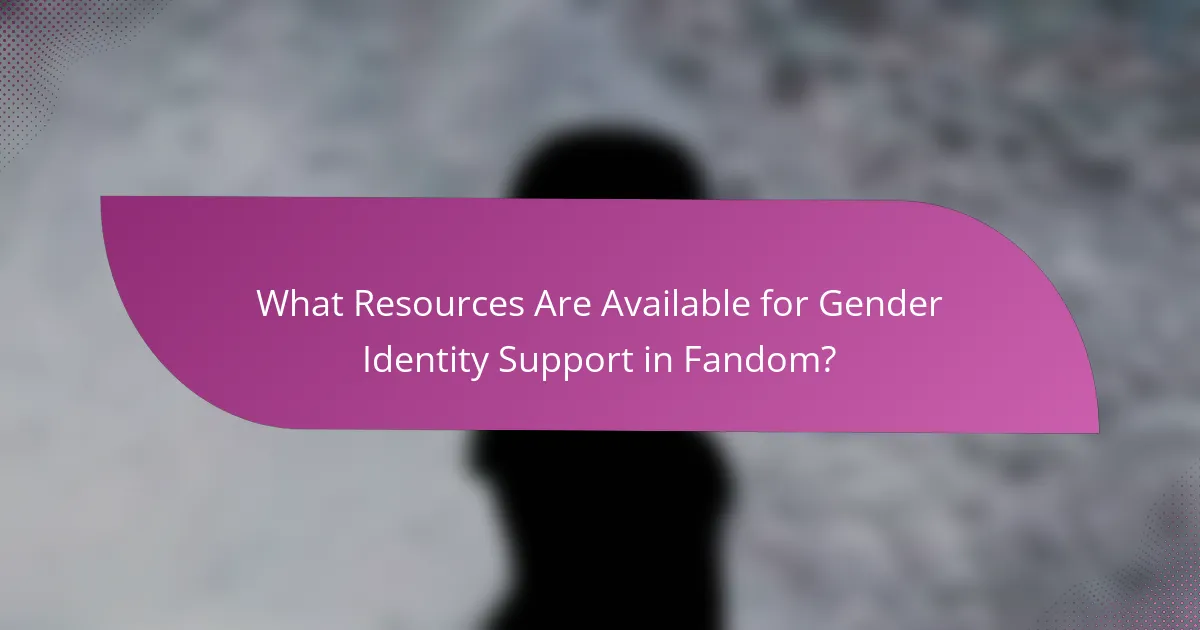
What Resources Are Available for Gender Identity Support in Fandom?
Numerous resources exist to support individuals exploring gender identity within fandom communities. These resources range from online platforms to literature and workshops, providing diverse avenues for connection and understanding.
Online platforms and forums
Online platforms and forums serve as vital spaces for individuals to discuss gender identity and share experiences. Websites like Tumblr, Reddit, and specialized forums offer communities where users can ask questions, seek advice, and find solidarity among peers.
When engaging in these platforms, consider joining specific groups that focus on gender identity to ensure a supportive environment. Be mindful of the community guidelines and respect others’ experiences to foster a positive atmosphere.
Books and literature
Books and literature provide in-depth insights into gender identity and expression. Titles such as “Gender [censured]” by Maia Kobabe and “The Gendered Self” by Judith Butler are excellent starting points for understanding various perspectives and experiences.
Additionally, many local libraries and bookstores may have sections dedicated to [censured] literature. Exploring these resources can enhance your understanding and provide context for discussions within fandoms.
Workshops and events
Workshops and events focused on gender identity often occur in community centers, universities, or online. These gatherings can include panel discussions, creative workshops, and support groups, allowing participants to engage actively with the topic.
To find relevant events, check local [censured] organizations or online event platforms. Attending these workshops can offer practical tools and foster connections with others navigating similar journeys.
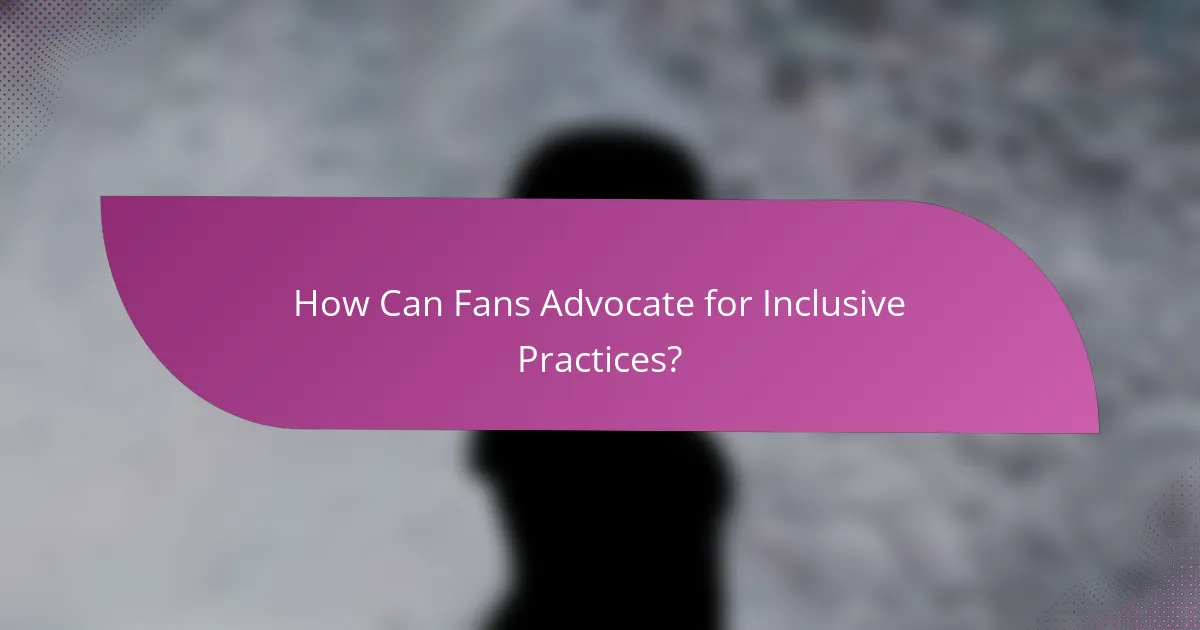
How Can Fans Advocate for Inclusive Practices?
Fans can advocate for inclusive practices by actively promoting diversity in content and engaging with creators to ensure representation. This involves creating supportive environments where all identities are respected and celebrated.
Creating inclusive content
Inclusive content reflects a variety of gender identities and expressions, allowing fans to see themselves represented. This can include diverse character backgrounds, storylines that explore gender fluidity, and language that respects pronouns. Fans can encourage creators to incorporate these elements by providing feedback and sharing examples of successful representation.
When creating fan works, such as fan fiction or art, consider using inclusive language and themes. For instance, avoid stereotypes and instead focus on authentic narratives that resonate with different gender identities. This approach not only enriches the content but also fosters a sense of belonging within the community.
Engaging with creators
Engaging with creators is crucial for advocating inclusive practices. Fans can reach out through social media, attend conventions, or participate in Q&A sessions to express their desire for more diverse representation. Constructive feedback can guide creators in understanding the importance of inclusivity in their work.
Additionally, supporting creators who prioritize diversity can amplify their voices. This can be done by purchasing their work, sharing their content, or participating in crowdfunding campaigns. By backing inclusive creators, fans help to shift industry standards towards more representative practices.
Organizing community events
Organizing community events can foster inclusivity and provide a platform for diverse voices. Fans can host panels, workshops, or discussion groups that focus on gender identity and expression within fandoms. These events can help educate attendees and create a supportive network.
Consider partnering with local organizations that advocate for gender diversity to enhance the impact of these events. Collaborating with experts can provide valuable insights and resources, making the events more informative and engaging. Always ensure that the events are accessible to all, considering factors like location, timing, and inclusivity of language used in promotions.
